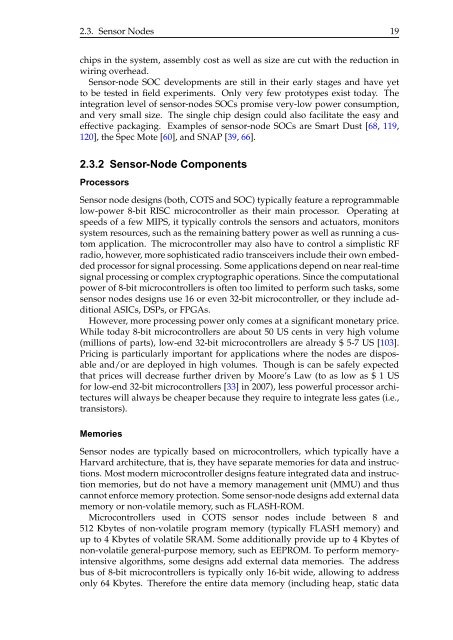A State-Based Programming Model for Wireless Sensor Networks
A State-Based Programming Model for Wireless Sensor Networks
A State-Based Programming Model for Wireless Sensor Networks
You also want an ePaper? Increase the reach of your titles
YUMPU automatically turns print PDFs into web optimized ePapers that Google loves.
2.3. <strong>Sensor</strong> Nodes 19<br />
chips in the system, assembly cost as well as size are cut with the reduction in<br />
wiring overhead.<br />
<strong>Sensor</strong>-node SOC developments are still in their early stages and have yet<br />
to be tested in field experiments. Only very few prototypes exist today. The<br />
integration level of sensor-nodes SOCs promise very-low power consumption,<br />
and very small size. The single chip design could also facilitate the easy and<br />
effective packaging. Examples of sensor-node SOCs are Smart Dust [68, 119,<br />
120], the Spec Mote [60], and SNAP [39, 66].<br />
2.3.2 <strong>Sensor</strong>-Node Components<br />
Processors<br />
<strong>Sensor</strong> node designs (both, COTS and SOC) typically feature a reprogrammable<br />
low-power 8-bit RISC microcontroller as their main processor. Operating at<br />
speeds of a few MIPS, it typically controls the sensors and actuators, monitors<br />
system resources, such as the remaining battery power as well as running a custom<br />
application. The microcontroller may also have to control a simplistic RF<br />
radio, however, more sophisticated radio transceivers include their own embedded<br />
processor <strong>for</strong> signal processing. Some applications depend on near real-time<br />
signal processing or complex cryptographic operations. Since the computational<br />
power of 8-bit microcontrollers is often too limited to per<strong>for</strong>m such tasks, some<br />
sensor nodes designs use 16 or even 32-bit microcontroller, or they include additional<br />
ASICs, DSPs, or FPGAs.<br />
However, more processing power only comes at a significant monetary price.<br />
While today 8-bit microcontrollers are about 50 US cents in very high volume<br />
(millions of parts), low-end 32-bit microcontrollers are already $ 5-7 US [103].<br />
Pricing is particularly important <strong>for</strong> applications where the nodes are disposable<br />
and/or are deployed in high volumes. Though is can be safely expected<br />
that prices will decrease further driven by Moore’s Law (to as low as $ 1 US<br />
<strong>for</strong> low-end 32-bit microcontrollers [33] in 2007), less powerful processor architectures<br />
will always be cheaper because they require to integrate less gates (i.e.,<br />
transistors).<br />
Memories<br />
<strong>Sensor</strong> nodes are typically based on microcontrollers, which typically have a<br />
Harvard architecture, that is, they have separate memories <strong>for</strong> data and instructions.<br />
Most modern microcontroller designs feature integrated data and instruction<br />
memories, but do not have a memory management unit (MMU) and thus<br />
cannot en<strong>for</strong>ce memory protection. Some sensor-node designs add external data<br />
memory or non-volatile memory, such as FLASH-ROM.<br />
Microcontrollers used in COTS sensor nodes include between 8 and<br />
512 Kbytes of non-volatile program memory (typically FLASH memory) and<br />
up to 4 Kbytes of volatile SRAM. Some additionally provide up to 4 Kbytes of<br />
non-volatile general-purpose memory, such as EEPROM. To per<strong>for</strong>m memoryintensive<br />
algorithms, some designs add external data memories. The address<br />
bus of 8-bit microcontrollers is typically only 16-bit wide, allowing to address<br />
only 64 Kbytes. There<strong>for</strong>e the entire data memory (including heap, static data
















